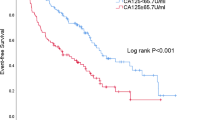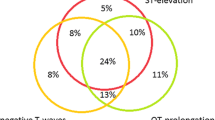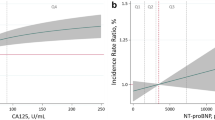Abstract
Serum carbohydrate antigen (CA-125) and carcinoembryonic antigen (CEA) have always been of clinical importance in the diagnosis and follow-up of various tumors. This study was devised to investigate the relationship between these tumor markers and acute myocardial infarction (MI). Seventy consecutive cases (59 male patients with a diagnosis of acute ST segment elevation MI and 11 male patients with a diagnosis of non-ST segment elevation MI; mean age, 57±8.2 y) were admitted to the University Medical Center and were included in this study as “the patient group.” All patients in the patient group underwent transthoracic echocardiographic examination on the third day of hospitalization. On the basis of echocardiographic findings, these 70 patients were grouped according to left ventricular ejection fraction (EF) values; EF < 55% (group 1) (n=40) and EF≥55% (group 2) (n=30). Other parameters, including systolic pulmonary artery pressure (sPAP) and mean pulmonary artery pressure (mPAP), were also measured on transthoracic echocardiography. Serial blood samples (for follow-up of myocardial enzymes (eg, creatine kinase MB [CKMB], troponin I [TnI], troponin T, and other routine parameters) were drawn from each patient. Serum concentrations of CEA and CA-125 measured at the 72nd hour of hospitalization and peak serum concentrations of CKMB and TnI in the patient group were collected for comparison between subgroups (groups 1 and 2) and with “the control group”, which included 30 subjects (mean age, 54±7.6 y) with no history or evidence of overt cardiac disease and with normal echocardiographic findings. The presence of any condition characterized by potential elevations in CA-125, CEA, and myocardial enzymes (CKMB, TnI) was considered an exclusion criterion. Patients included in patient groups 1 and 2 differed significantly in terms of mean EF, mean sPAP, mean mPAP, and mean CA-125 values (P < .001 for CA-125;P < .05 for the other values). EF was found to be negatively correlated with sPAP (r=-0.692,P=.000) and mPAP (r=-0.393,P=.001). EF was also negatively correlated with CA-125 (r=-0.557,P=.000). A positive correlation was noted between CA-125 and sPAP (r=0.396,P=.001) and between CA-125 and mPAP (r=0.754,P=.000). A statistically significant difference was identified between the patient and control groups with regard to values for EF, PAP, CA-125, and myocardial enzymes (CKMB and TnI) (P < .05 for mPAP;P < .001 for the other values). The serum concentration of CA-125, but not of CEA, may be elevated in those with acute MI compared with normal subjects. Regardless of the presence of pulmonary hypertension, elevations in CA-125 during myocardial infarction were significantly correlated with the severity of left ventricular systolic dysfunction on transthoracic echocardiography.
Similar content being viewed by others
References
Bast RC Jr, Klug TL, St John E, et al. A radioimmunoassay using a monoclonal antibody to monitor the course of epithelial ovarian cancer.N Engl J Med. 1983; 309: 883–887.
Canney PA, Moore M, Wilkinson PM, James RD. Ovarian cancer antigen CA125: a prospective clinical assessment of its role as a tumor marker.Br J Cancer. 1984; 50: 765–769.
Lazzarino M, Orlandi E, Klersy C, et al. Serum CA 125 is of clinical value in the staging and follow-up of patients with non-Hodgkin’s lymphoma: correlation with tumor parameters and disease activity.Cancer. 1998; 82: 576–582.
Sakamoto K, Haga Y, Yoshimura R, Egami H, Yokoyama Y, Akagi M. Comparative effectiveness of the tumour diagnostics CA 19–9, CA 125 and carcinoembryonic antigen in patients with diseases of the digestive system.Gut. 1987; 28: 323–329.
Klapdor R, Klapdor U, Bahlo M, et al. CA 125 in carcinomas of the digestive tract.Dtsch Med Wochenschr. 1984; 199: 1949–1954.
Bergmann JF, Bidart JM, George M, Beaugrand M, Levy VG, Bohuon C. Elevation of CA 125 in patients with benign and malignant ascites.Cancer. 1987; 59: 213–217.
Seo T, Ikeda Y, Onaka H, et al. Usefulness of serum CA125 measurement for monitoring pericardial effusion.Jpn Circ J. 1993; 57: 489–494.
Nagele H, Bahlo M, Klapdor R, Schaeperkoetter D, Rodiger W. CA125 and its relation to cardiac function.Am Heart J. 1999; 137: 1044–1049.
D’Aloia A, Faggiano P, Aurigemma G, et al. Serum levels of carbohydrate antigen 125 in patients with chronic heart failure: relation to clinical severity, hemodynamic and Doppler echocardiographic abnormalities and short term prognosis.J Am Coll Cardiol. 2003; 41: 1805–1811.
Fletcher RH. Carcinoembryonic antigen.Ann Intern Med. 1996; 104: 66–73.
American Society of Clinical Oncology. Clinical practice guidelines for the use of tumor markers in breast and colorectal cancer.J Clin Oncol. 1996; 14: 2843–2877.
Schiller NB, Shah PM, Crawford M, et al. Recommendations for quantitation of left ventricle by two-dimensional echocardiography. American Society of Echocardiography on Standards, Subcommittee on Quantitation of Two-Dimensional Echocardiograms.J Am Soc Echocardiogr. 1989; 2: 358–367.
Tuxen MK, Soletormos G, Dombernowsky P. Tumor markers in the management of patients with ovarian cancer.Cancer Treat Rev. 1995; 21: 215–245.
Ozguroglu M, Turna H, Demir G, et al. Usefulness of the epithelial tumor marker CA-125 in non-Hodgkin’s lymphoma.Am J Clin Oncol. 1999; 22: 615–618.
Lazzarino M, Orlandi E, Klersy C, et al. Serum CA 125 is of clinical value in the staging and follow-up of patients with non-Hodgkin’s lymphoma: correlation with tumor parameters and disease activity.Cancer. 1998; 82: 576–582.
Zacharos ID, Efstathiou SD, Petreli E, et al. The prognostic significance of CA 125 in patients with non-Hodgkin’s lymphoma.Eur J Haematol. 2002; 69: 221–226.
Gallup DG, Talledo E. Management of the adnexal mass in the 1990s.South Med J. 1997; 90: 972–981.
Halila H, Stenman UH, Seppala M. Ovarian cancer antigen CA 125 levels in pelvic inflammatory disease and pregnancy.Cancer. 1986; 57: 1327–1329.
Barbieri RL, Niloff JM, Bast RC, Schaetzi RN, Kirstner RW, Knapp RC. Elevated serum concentrations of CA 125 in patients with advanced endometriosis.Fertil Steril. 1986; 45: 630–634.
Candocia SA, Locker GY. Elevated serum CA 125 secondary to tuberculous peritonitis.Cancer. 1993; 72: 2016–2018.
Okazaki K, Mizuno K, Katoh K, Hashomoto S, Fukuchi S. Tuberculous peritonitis with extraordinarily high serum CA 125.J Med. 1992; 23: 353–361.
Tuxen MK, Soletormos G, Dombernowsky P. Tumor markers in the management of patients with ovarian cancer.Cancer Treat Rev. 1995; 21: 215–245.
Gallup DG, Talledo E. Management of the adnexal mass in the 1990s.South Med J. 1997; 90: 972–981.
Chen DX, Schwartz PE, Li XG, Yang Z. Evaluation of CA 125 levels in differentiating malignant from benign tumors in patients with pelvic masses.Obstet Gynecol. 1988; 72: 23–27.
Kouris NT, Zacharos ID, Kontogianni DD, et al. The significance of CA 125 levels in patients with chronic congestive heart failure: correlation with clinical and echocardiographic parameters.Eur J Heart Fail. 2005; 7: 199–203.
Camera A, Villa MR, Rocco S, et al. Increased CA 125 serum levels in patients with advanced acute leukemia with serosal involvement.Cancer. 2000; 88: 75–78.
MacGowan GA, Mann DL, Kormos RL, Feldman AM, Murali S. Circulating interleukin-6 in severe heart failure.Am J Cardiol. 1997; 79: 1128–1131.
Kubonishi I, Bandobashi K, Murata N, et al. High serum levels of CA125 and interleukin-6 in a patient with Ki-1 lymphoma.Br J Haematol. 1997; 98: 450–452.
Maytin M, Colucci WS. Molecular and cellular mechanisms of myocardial remodeling.J Nucl Cardiol. 2002; 9: 319–327.
Thaik CM, Calderone A, Takahashi N, Colucci WS. Interleukin-1 beta modulates the growth and phenotype of neonatal rat cardiac myocytes.J Clin Invest. 1995; 96: 1093–1099.
Author information
Authors and Affiliations
Rights and permissions
About this article
Cite this article
Yalta, K., Yilmaz, A., Turgut, O.O. et al. Evaluation of tumor markers CA-125 and CEA in acute myocardial infarction. Adv Therapy 23, 1052–1059 (2006). https://doi.org/10.1007/BF02850225
Issue Date:
DOI: https://doi.org/10.1007/BF02850225




